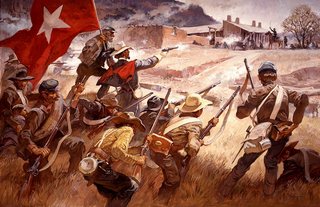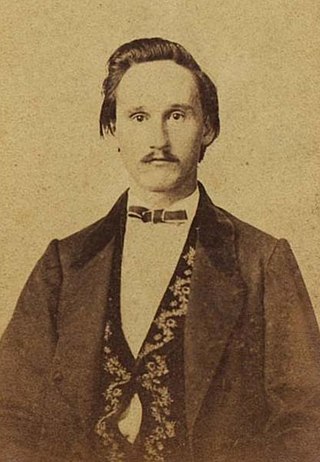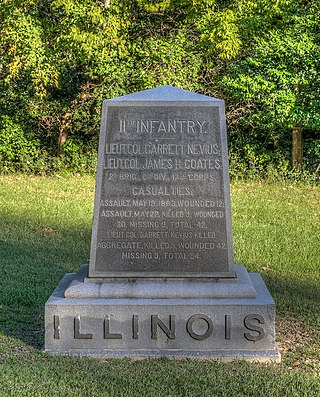
The New Mexico campaign was a military operation of the trans-Mississippi theater of the American Civil War from February to April 1862 in which Confederate Brigadier General Henry Hopkins Sibley invaded the northern New Mexico Territory in an attempt to gain control of the Southwest, including the gold fields of Colorado and the ports of California. Historians regard this campaign as the most ambitious Confederate attempt to establish control of the American West and to open an additional theater in the war. It was an important campaign in the war's Trans-Mississippi Theater, and one of the major events in the history of the New Mexico Territory in the American Civil War.

The Battle of Big Bethel was one of the earliest land battles of the American Civil War. It took place on the Virginia Peninsula, near Newport News, on June 10, 1861.

The siege of Knoxville saw Lieutenant General James Longstreet's Confederate forces besiege the Union garrison of Knoxville, Tennessee, led by Major General Ambrose Burnside. When Major General William T. Sherman approached Knoxville with an overwhelming Union force, Longstreet ended the siege on December 4 and withdrew northeast. The siege was part of the Knoxville campaign of the American Civil War.

The Battle of Valverde, also known as the Battle of Valverde Ford, was fought from February 20 to 21, 1862, near the town of Val Verde at a ford of the Rio Grande in Union-held New Mexico Territory, in what is today the state of New Mexico. It is considered a major Confederate success in the New Mexico Campaign of the American Civil War, despite the invading force abandoning the field and, eventually, retreating from the territory entirely. The belligerents were Confederate cavalry from Texas and several companies of Arizona militia versus U.S. Army regulars and Union volunteers from northern New Mexico Territory and the Colorado Territory.

The Red River campaign, also known as the Red River expedition, was a major Union offensive campaign in the Trans-Mississippi theater of the American Civil War, which took place from March 10 to May 22, 1864. It was launched through the densely forested gulf coastal plain region between the Red River Valley and central Arkansas towards the end of the war. The offensive was intended to stop Confederate use of the Louisiana port of Shreveport, open an outlet for the sugar and cotton of northern Louisiana, and to split the Confederate lines, allowing the Union to encircle and destroy the Confederate military forces in Louisiana and southern Arkansas. It marked the last major offensive attempted by the Union in the Trans-Mississippi Theater.
The Battle of Fort Bisland was fought in the American Civil War between Union Major General Nathaniel P. Banks against Confederate Major General Richard Taylor during Banks' operations against the Bayou Teche region in southern Louisiana.

The Battle of Irish Bend, also known as Nerson's Woods or Franklin, took place during the American Civil War. It was fought between Union Major General Nathaniel Prentice Banks against Confederate Major General Richard Taylor during Banks's operations against the Bayou Teche region near Franklin, the seat of St. Mary Parish in southern Louisiana.

The 27th Wisconsin Volunteer Infantry Regiment was an infantry regiment that served in the Union Army during the American Civil War. The regiment began organizing in August 1862 but recruiting problems delayed its entry into federal service until March 1863. Predominantly from the Lake Michigan shore counties of the state, the regiment was mainly composed of German immigrants. The 27th Wisconsin played a supporting role in the Siege of Vicksburg and participated in the capture of Little Rock, Arkansas during the year. The regiment served in the Little Rock garrison and saw its first serious combat in the Camden Expedition of 1864, during which it fought in the Battle of Jenkins' Ferry. The regiment was among the Union forces in the Mobile campaign in early 1865, and was involved in the Battle of Spanish Fort. Ending the war in the occupation of Texas, the regiment was mustered out in August before returning to Wisconsin.
The Second Battle of Donaldsonville was an American Civil War battle took place on June 28, 1863 in Ascension Parish, Louisiana.
The Battle of Stirling's Plantation was an American Civil War battle took place on September 29, 1863 in Pointe Coupee Parish, Louisiana.
The 26th Indiana Volunteer Infantry Regiment was an infantry regiment that served in the Union Army during the American Civil War.

The 13th Maine Infantry Regiment was an infantry regiment that served in the Union Army during the American Civil War. The regiment spent 1862–1864 in the Department of the Gulf and finished the war with the Army of the Shenandoah. During its service, it survived a hurricane off the Carolinas en route the Gulf of Mexico, manned the forts guarding the Mississippi Delta, invaded Texas at the Rio Grande and along the coast, fought in Banks' ill-fated Red River Campaign in Louisiana, manned Washington, D.C., defenses, and provided rear-area security for the Shenandoah Valley campaign in 1864 south of Harpers Ferry.
The Company A, Arizona Rangers was a cavalry formation of the Confederate States Army during the American Civil War.
The 15th Maine Infantry Regiment was an infantry regiment that served in the Union Army during the American Civil War.

The 10th Arkansas Infantry (1861–1865) was a Confederate Army infantry regiment during the American Civil War from the state of Arkansas. The unit is also known as A. R. Witt's Infantry, C. M. Cargile's Infantry, E. L. Vaughan's Infantry, Thomas D. Merrick's Infantry, S. S. Ford's Infantry, Obed Patty's Infantry, George A. Merrick's Infantry, Zebulon Venable's Infantry and Robert C. Bertrand's Infantry in contemporary accounts. After being captured at the Siege of Port Hudson, the unit reorganized as a mounted infantry unit, and was known as the 10th Arkansas Cavalry Regiment or Witt's Arkansas Cavalry.

The 11th Regiment Illinois Volunteer Infantry was an infantry regiment from Illinois that served in the Union Army during the American Civil War. In April 1861, it was formed as a three-month volunteer unit, and in July 1861 it was reorganized as a three-year unit, in which role it served until the end of the war. Two of its commanding officers were promoted to brigadier general and led major units during the war. In its first major action at Fort Donelson the regiment suffered terrible losses. The 11th Illinois also fought at Shiloh, Riggins Hill, Vicksburg, First Yazoo City, Second Yazoo City, and Fort Blakely. In April 1863, the 109th Illinois Infantry Regiment was disbanded and its enlisted men transferred into the 11th Illinois. The regiment was mustered out of service in July 1865.
The Battle of Fort Esperanza was fought in Texas during the American Civil War. Maj. Gen. Cadwallader C. Washburn led two brigades from the Union XIII Corps to capture a fort on Matagorda Island defended by Colonel William R. Bradfute and a small Confederate garrison. After some skirmishing, the Confederates evacuated the fort. Casualties were light on both sides.

Francis Snow Hesseltine was a Union Army soldier in the American Civil War who received the U.S. military's highest decoration, the Medal of Honor for extraordinary heroism on December 30, 1863, while serving as the lieutenant colonel of the 13th Maine Volunteer Infantry Regiment, at Matagorda Bay, Texas. His Medal of Honor was issued on March 2, 1895.

Battery E, 1st Missouri Light Artillery Regiment was an artillery battery unit from Missouri that served in the Union Army during the American Civil War. The 1st Missouri Light Artillery Regiment formed on 1 September 1861. The battery participated in Frémont's expedition to Springfield in October 1861. This was followed by actions at Prairie Grove and Van Buren in December 1862. The following year, the battery fought at Cape Girardeau, Chalk Bluff, Vicksburg, the Expedition to Morganza, Brownsville, and Fort Esperanza. After performing garrison duty at Brownsville, Texas, the unit was mustered out in June 1864. For a few months at the end of 1864, a Pennsylvania battery took the name of this unit.

1st Texas Field Battery or Edgar's Company was an artillery battery from Texas that served in the Confederate States Army during the American Civil War. The artillery company formed in November 1860, but was not formally taken into Confederate service until April 1861. The unit participated in the disarming and surrender of United States soldiers and property in Texas in early 1861. The battery marched to Arkansas where in 1862 it joined the infantry division known as Walker's Greyhounds. The battery fought at Milliken's Bend and Richmond (La.), shelled a Federal river transport, and campaigned in south Louisiana in late 1863. The 1st Texas Battery was captured at Henderson's Hill in March 1864. The soldiers were later exchanged, and the unit disbanded in 1865 at the end of the conflict.














